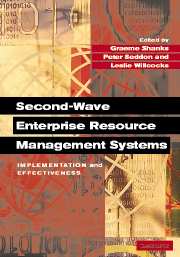Book contents
- Frontmatter
- Contents
- List of Contributors
- Introduction: ERP – The Quiet Revolution?
- Part I Implementation and Effectiveness: Overview
- Part II From Risks to Critical Success Factors
- 5 Enterprise System Implementation Risks and Controls
- 6 Risk Factors in Enterprise-wide/ERP Projects
- 7 A Framework for Understanding Success and Failure in Enterprise Resource Planning System Implementation
- 8 Critical Success Factors Revisited: A Model for ERP Project Implementation
- 9 Offsetting ERP Risk through Maintaining Standardized Application Software
- Part III From Learning to Knowledge
- Part IV Cultural Aspects of Enterprise Systems
- Part V Future Directions
- Index
- References
7 - A Framework for Understanding Success and Failure in Enterprise Resource Planning System Implementation
from Part II - From Risks to Critical Success Factors
Published online by Cambridge University Press: 05 February 2012
- Frontmatter
- Contents
- List of Contributors
- Introduction: ERP – The Quiet Revolution?
- Part I Implementation and Effectiveness: Overview
- Part II From Risks to Critical Success Factors
- 5 Enterprise System Implementation Risks and Controls
- 6 Risk Factors in Enterprise-wide/ERP Projects
- 7 A Framework for Understanding Success and Failure in Enterprise Resource Planning System Implementation
- 8 Critical Success Factors Revisited: A Model for ERP Project Implementation
- 9 Offsetting ERP Risk through Maintaining Standardized Application Software
- Part III From Learning to Knowledge
- Part IV Cultural Aspects of Enterprise Systems
- Part V Future Directions
- Index
- References
Summary
Introduction
Companies continue to move away from developing IT systems in-house and purchase instead standard package software. PriceWaterhouse (1995) predicted that by the year 2000, two-thirds of all business software would be bought off the shelf. Following this Deloitte and Touche (1997) stated that enterprise resource planning (ERP) systems, standard package-based software that supports core business processes, were the preferred method by which businesses replaced ‘legacy systems’. In 2000 a Consultant's Advisory survey indicated that 61% of respondents planned to invest in existing or new ERP implementations. The use of standard systems has been the predominant strategy for several years in the area of desktop computing and it is clearly now being adopted elsewhere in organizations.
Even in the light of the phenomenal uptake of this form of strategy and subsequent potential for learning, implementation is still problematic for many organizations. There are mixed reports concerning the outcome of ERP projects. Successful ERP implementations are certainly publicised, such as Monsanto (Edmondson, Baker, and Cortese, 1997) and Guilbert-Niceday (Gibson, Holland, and Light, 1999), but less-successful attempts, such as FoxMeyer Drug (Bicknell, 1998; James, 1997), have received limited attention. It is estimated that at least 90% of ERP implementations end up late or over budget (Martin, 1998). However, this may be due to poor cost and time estimation rather than a failure in project management. Changes in the scope of ERP projects may also contribute to this figure (Holland and Light, 1999).
- Type
- Chapter
- Information
- Second-Wave Enterprise Resource Planning SystemsImplementing for Effectiveness, pp. 180 - 195Publisher: Cambridge University PressPrint publication year: 2003
References
- 5
- Cited by



